Page snapshot: An overview of lawns, including common lawn grasses, the benefits and drawbacks of lawns, lawn grass alternatives, and sustainable lawn maintenance.
Topics covered on this page: Introduction; Common lawn grasses; Cool-season grasses; Warm-season grasses; Benefits of manicured lawns; Aesthetics and cultural values; Recreation; Damage prevention; Deterring pests; Drawbacks of manicured lawns; Impacts on biodiversity; Air pollution; Noise pollution; Water depletion; Water pollution; Lawn alternatives; Moss; Wildflower gardens; Ground covers; Sustainable practices for maintaining a lawn; Resources.
Credits: Funded by the National Science Foundation. Any opinions, findings, and conclusions or recommendations expressed in this material are those of the author(s) and do not necessarily reflect the views of the National Science Foundation. Page by Deme Burns (2023).
Updates: Page last updated August 13, 2023.
Image above: Man mowing a large lawn using a riding lawnmower, Sweden. Photo by W. Carter. (Wikimedia Commons, Creative Commons CC0 1.0 Universal Public Domain, photo resized).
Introduction
Lawns are one of the largest irrigated agricultural “crops” in the United States. In fact, lawns take up more space than corn, wheat, and fruit orchards combined. According to a NASA study, 63,000 square miles of the United States are devoted to grass. For perspective, this is larger than the state of Georgia.

A housing development in Markham, Ontario, Canada, 2005. Each fouse is surrounded by lawns in the back and front. Photo by IDuke, edited by Sting (Wikimedia Commons, Creative Commons Attribution-ShareAlike 2.5 Generic license, image cropped).
Lawns have recreational, social, symbolic, aesthetic, and protective functions, which is why many people find it highly desirable to have one. Lawns provide an area for children and pets to play around the house and are also used in playgrounds, parks, and athletic fields to provide people places to relax, play, and exercise. In the Northeast and Midwest U.S., mown grass eliminates habitats that may harbor pests near the house and help to prevent damage to the home (by, for example, reducing moisture and helping prevent rot). Lawns have social functions and are a place for large gatherings when not everyone can fit inside.
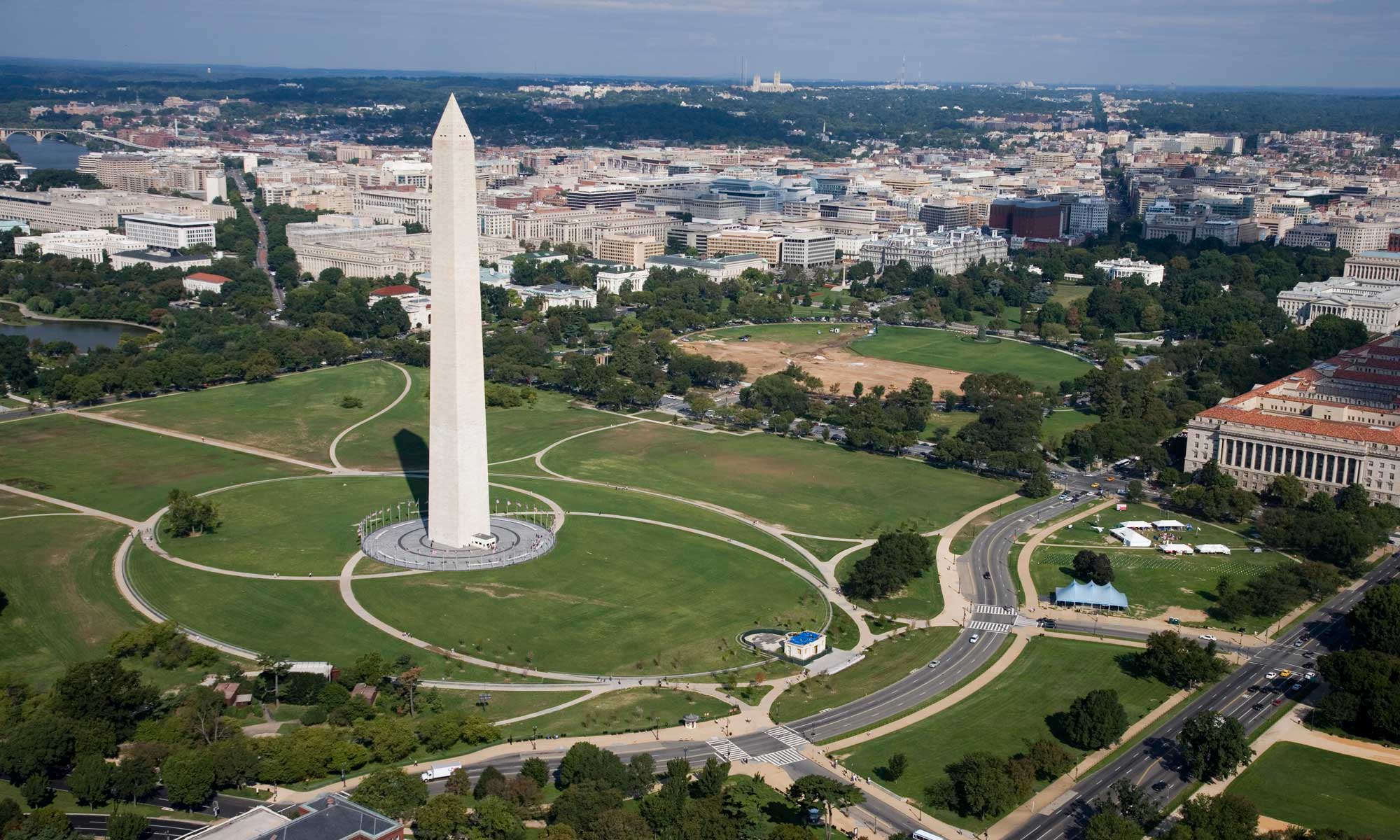
Large lawns surrounding the Washington Monument in Washington, D.C., U.S.A., 2006. Photo by Carol M. Highsmith (GPA Photo Archive on flickr, Creative Commons Attribution-NonCommercial 2.0 Generic license, image cropped and resized).
Nevertheless, lawns and lawn maintenance have many harmful impacts on the environment. The use of gas-powered lawnmowers and other equipment for yard maintenance (such as gas-powered leaf blowers and trimmers) significantly contributes to air pollution and climate change. Chemicals used to treat lawns can pollute waterways and promote algal blooms. Lawns can also have negative impacts on biodiversity.

A large manicured lawn in front of Lake Quinault Lodge, Washington, U.S.A. Photo by Joe Mabel (Wikimedia Commons, Creative Commons Attribution 4.0 International license. Photo resized.)
Common lawn grasses
A wide variety of grasses are used as lawn grasses, which are chosen (or perhaps grow naturally) depending a given area's climate, including temperature and amount of rainfall. Examples of some common lawn grasses are below.
Cool-season grasses
Cool-season grasses are species of grass that prefer cooler climates and grow the most during the spring and fall seasons, unlike warm-season grasses. Cool-season grasses usually grow in regions with cold winters and mild summers. These grasses are commonly used for lawns, golf courses, athletic fields, and other landscaping purposes. Some of the most common type of cool-season grasses used for lawns in North America include Kentucky bluegrass, perennial ryegrass, and tall fescue.
Kentucky bluegrass (Poa pratensis)
Kentucky bluegrass is native to Europe and northern Asia. It has a fine texture and is known for forming dense and uniform lawns. It thrives in areas with cold winters and moderate rainfall and is commonly used for parks and athletic fields because of its ability to tolerate heavy foot traffic. Drawbacks include the need for frequent mowing and fertilization to maintain it.
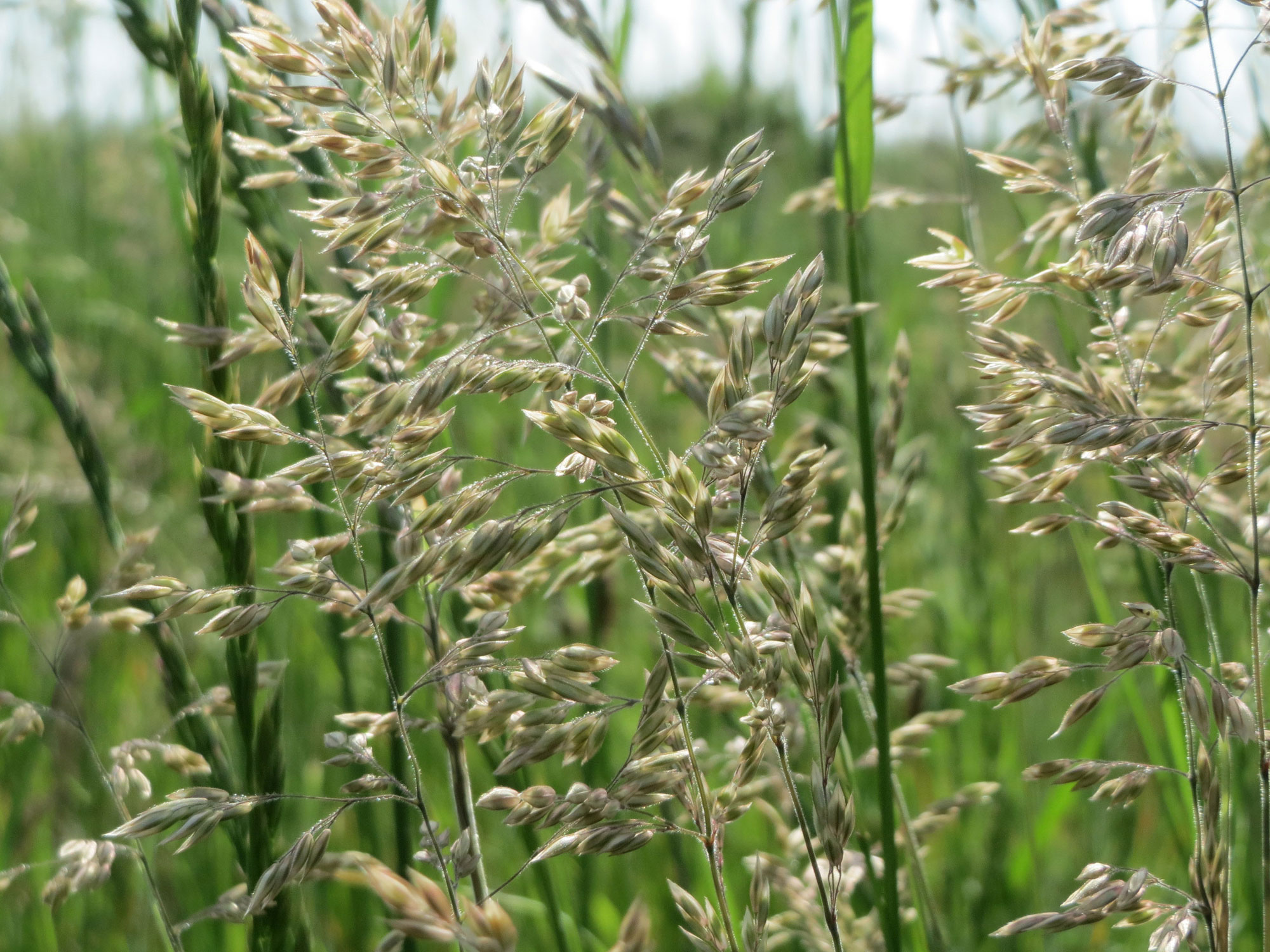
Kentucky bluegrass (Poa pratensis), Hockenheim, Germany. Despite its common English name, Kentucky bluegrass is native to North Africa and Eurasia. Photo by AnRo0002 (Wikimedia Commons, Creative Commons CC0 1.0 Universal/public domain dedication).
Perennial ryegrass (Lolium perenne)
Perennial ryegrass is a cool-season grass that is native to Europe, western Asia, and northern Africa. Now it is widely used as a forage grass due to its tolerance for grazing and for residential lawns, athletic fields, and erosion control because of its durability. It has a fine texture and forms dense turfs.
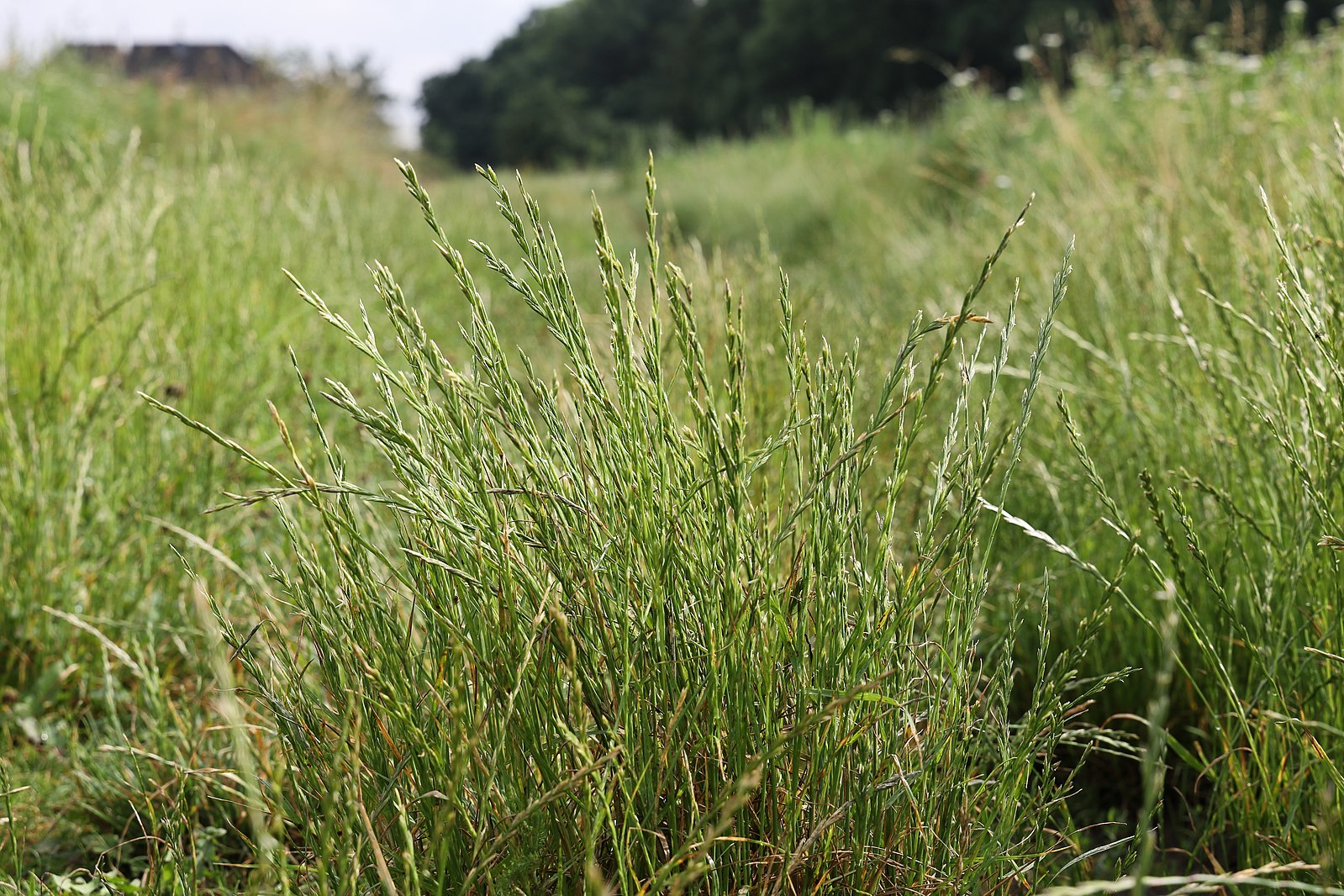
Perennial ryegrass (Lolium perenne). Photo by T. Kebert (Wikimedia Commons, Creative Commons Attribution-Share Alike 4.0 International license).
Tall fescue (Festuca arundinacea)
Tall fescue, known for its durability, is used for lawns in transition zones with both hot and cold weather. Tall fescue originated in Europe, western Asia, and northern Africa. It has a coarse texture and is known for its durability in varying climatic conditions, making it a popular choice for regions with cold winters and hot summers. It has deep roots that allow it to survive droughts and help with erosion control. Tall fescue is able grow in shaded areas and requires less maintenance than some other grasses.
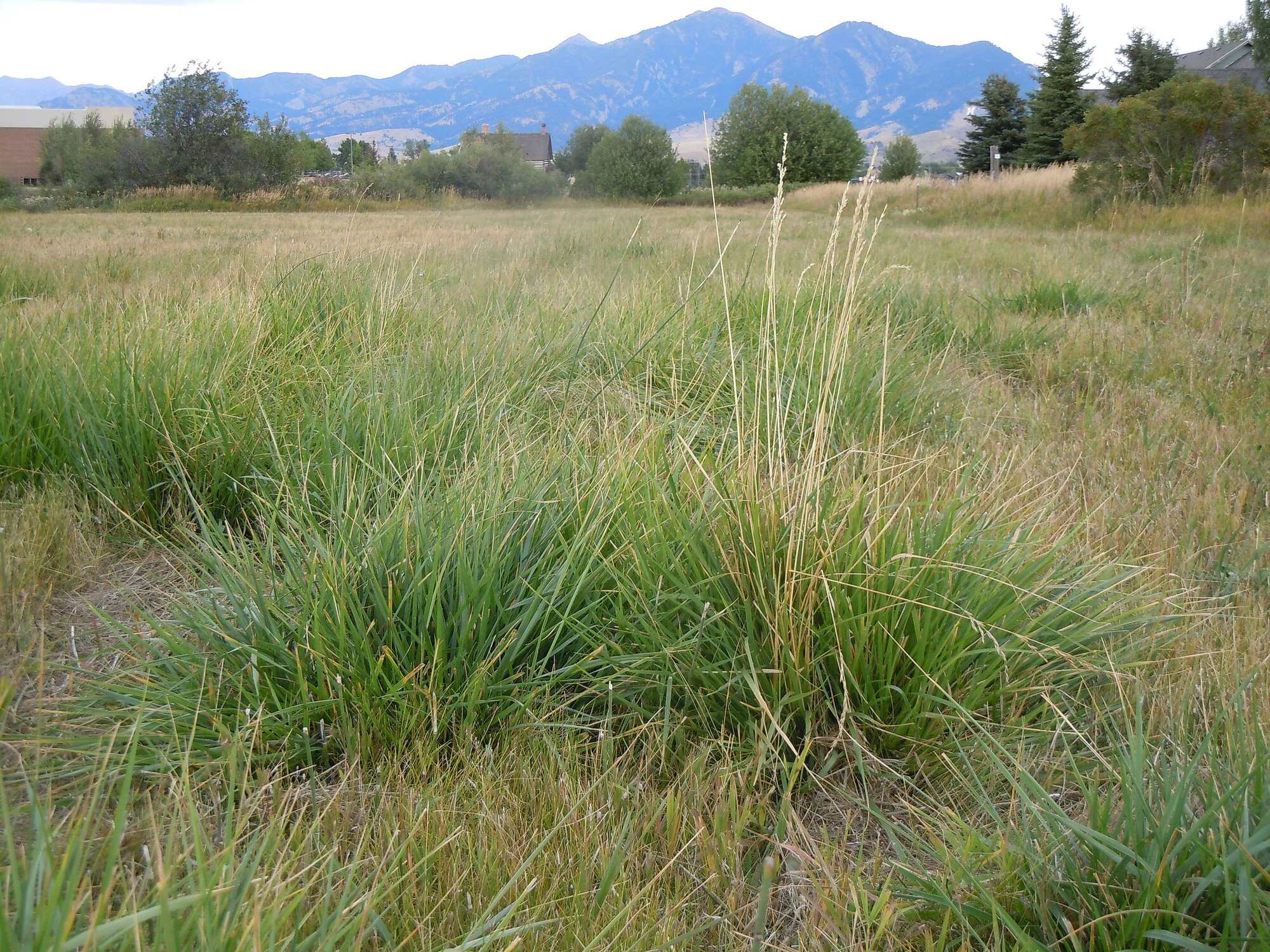
Tall fescue (Fesuca arundinacea), Montana, U.S.A, 2011. Photo by Matt Lavin (Wikimedia Commons, Creative Commons Attribution-Share Alike 2.0 Generic license, photo resized.)
Warm-season grasses
Warm-season grasses are grasses that grow best in warm climates and hit their peak growth in the summertime. They are adapted to areas with hot temperatures and are usually drought tolerant.
Bermuda grass (Cynodon dactylon)
Bermuda grass thrives in hot climates including southern United States and Mexico. Bermuda grass is native to Africa, parts of Eurasia, and Australia, and has been introduced to the Americas. It is mostly used for lawns, sports fields, golf courses, and erosion control. It has a fine texture and makes a dense turf. Its desirable attributes are rapid growth and quick recovery from damage. Bermuda grass is drought tolerant, heat tolerant, and can withstand heavy foot traffic.
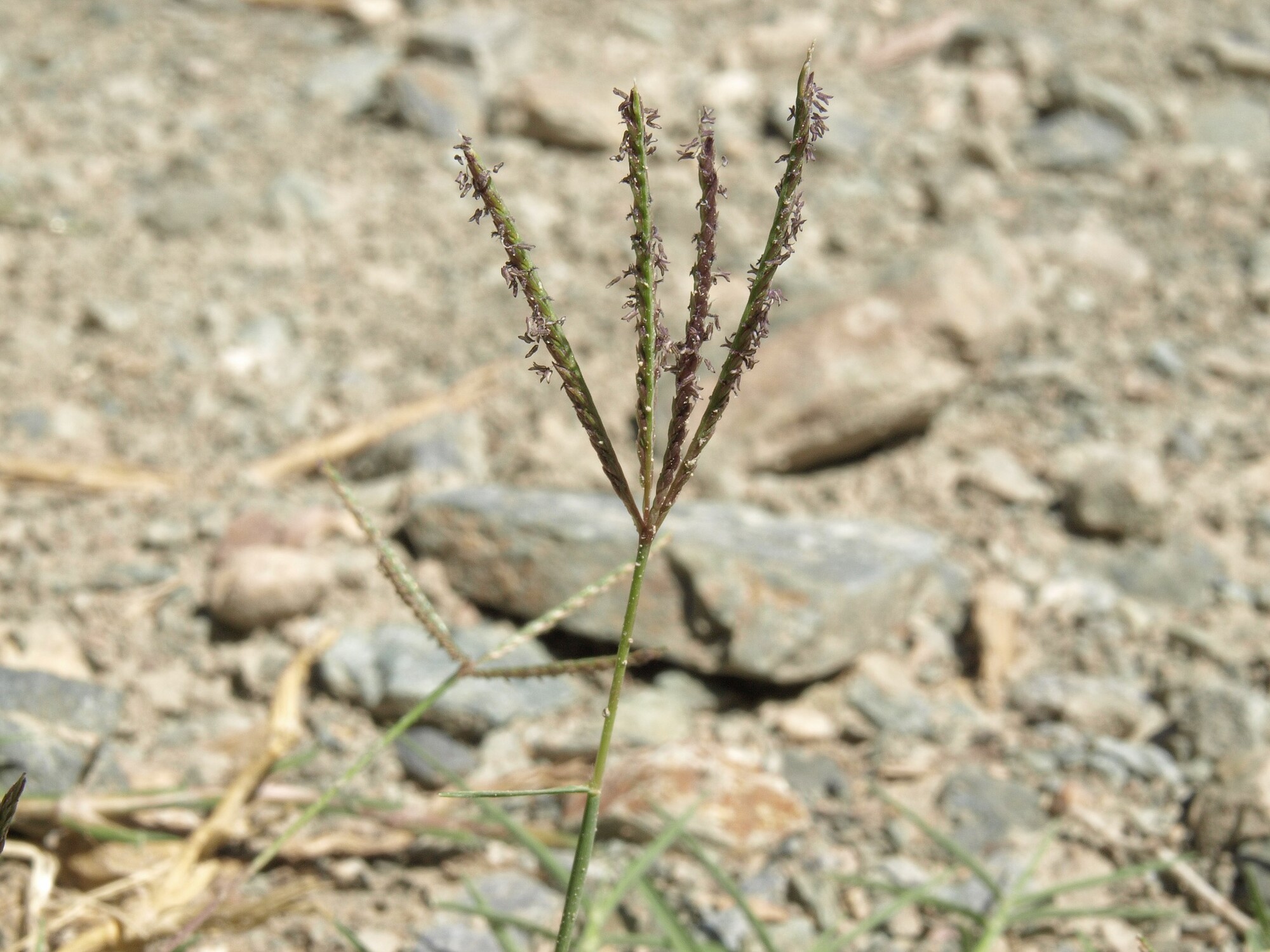
Bermuda grass (Cynodon dactylon). Photo by Jim Morefield (Wikimedia Commons, Creative Commons Attribution-Share Alike 2.0 Generic license, photo resized)
Bahia grass (Paspalum notatum)
Bahia grass is a South American lawn grass popular in arid, hot regions. It is a low maintenance option for lawns, roadsides, and pastures. It is heat tolerant and drought resistant and can grow in infertile soils, especially sandy areas. Bahia grass has a coarse texture and forms dense turf.
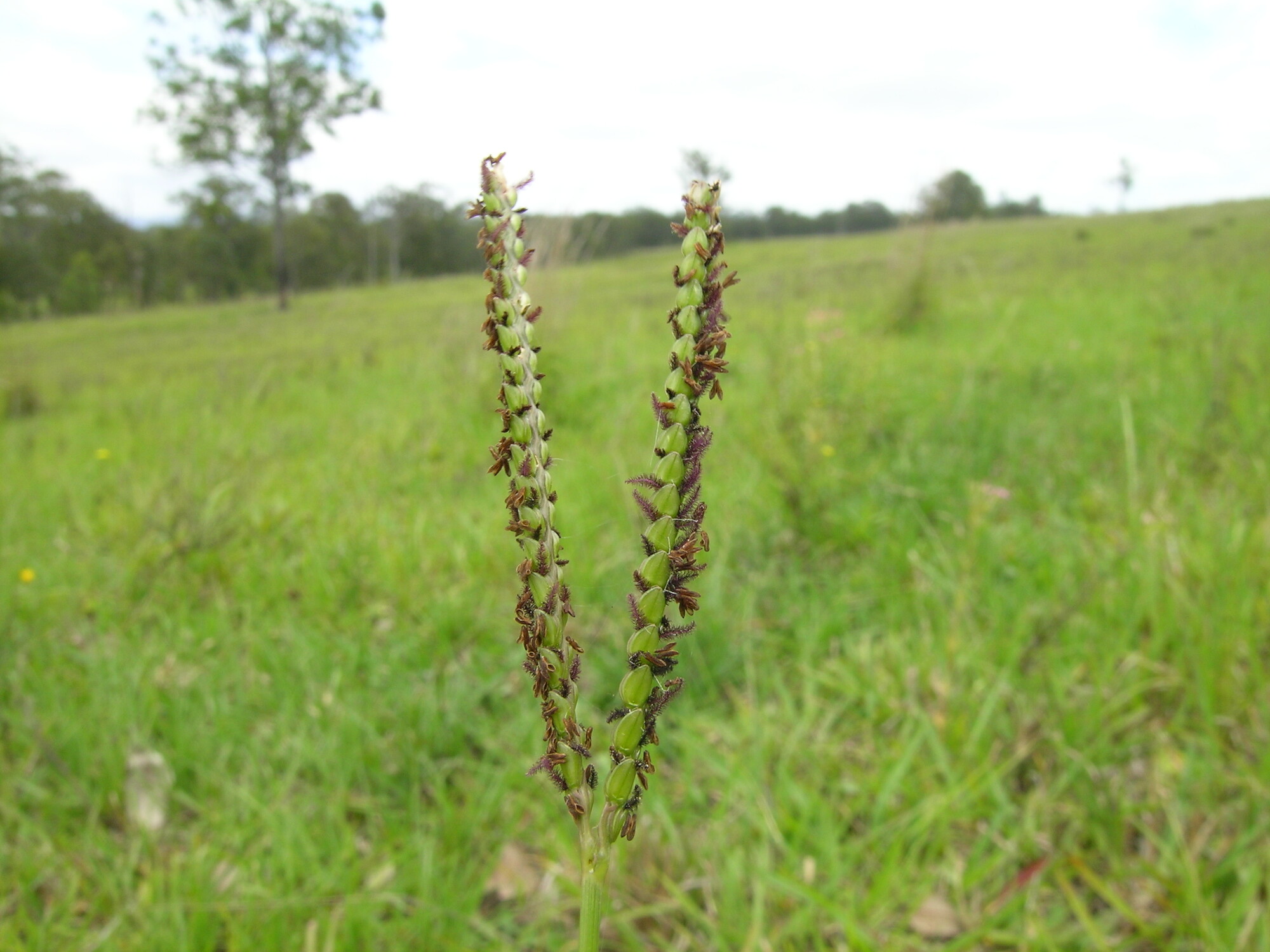
Bahia grass (Paspalum notatum). Photo by Harry Rose (Wikimedia Commons, Creative Commons Attribution 2.0 Generic license).
Centipede grass (Eremochloa ophiuroides)
Centipede grass is native to China and Southeast Asia. It is commonly used for lawns and is low maintenance. It forms a dense, carpet-like turf. It grows slowly and requires little mowing. It is tolerant of acidic soils, shady areas, and high heat. It requires mild winters and will not thrive in cold temperatures.

A honey bee on a centipede grass (Eremochloa ophiuroides) inflorescence. The pollen on the bees' legs is probably not from this grass, since the grass's anthers (pollen-producing structures) are mostly not visible. Photo by T.M. Jones (Wikimedia Commons, Creative Commons Attribution-Share Alike 3.0 Unported license, photo resized.)
Zoysia (Zoysia spp.)
Zoysia grass is soft and grows densely, creating a carpet-like visual appeal. The density of zoysia can fill gaps and suppress weed growth. Originally from Asia and Australia, zoysia thrives in warm climates and is drought and heat tolerant, maintaining its green color throughout the summer. It can withstand moderate foot traffic and recovers well from damage caused by foot traffic and children playing.

Zoysia grass in San Diego, California, U.S.A. The grass has grown over rocks contributing to the bumpy look of the grass. Photo by Hey Skinny. (Wikimedia Commons, Creative Commons Attribution 2.0 Generic license).
Benefits of manicured lawns
Aesthetics and cultural values
Some societies regard a manicured lawn as a sign of a put-together person that properly takes care of their property. Overgrown lawns, if not maintained properly, are seen to signify property abandonment and poverty. Having a clean-cut lawn reflects control, organization, hard work, and prosperity. It takes a lot of effort to maintain a lawn, and so an up-kept lawn suggests one has the time and money to devote to non-essential things. Many home owner associations, especially in large neighborhoods, require all homes to mow the lawn so the neighborhood has a sense of continuity and unity. Aesthetically, many people consider lawns attractive. They can decorate their lawn with patios, outdoor furniture, and other accessories.
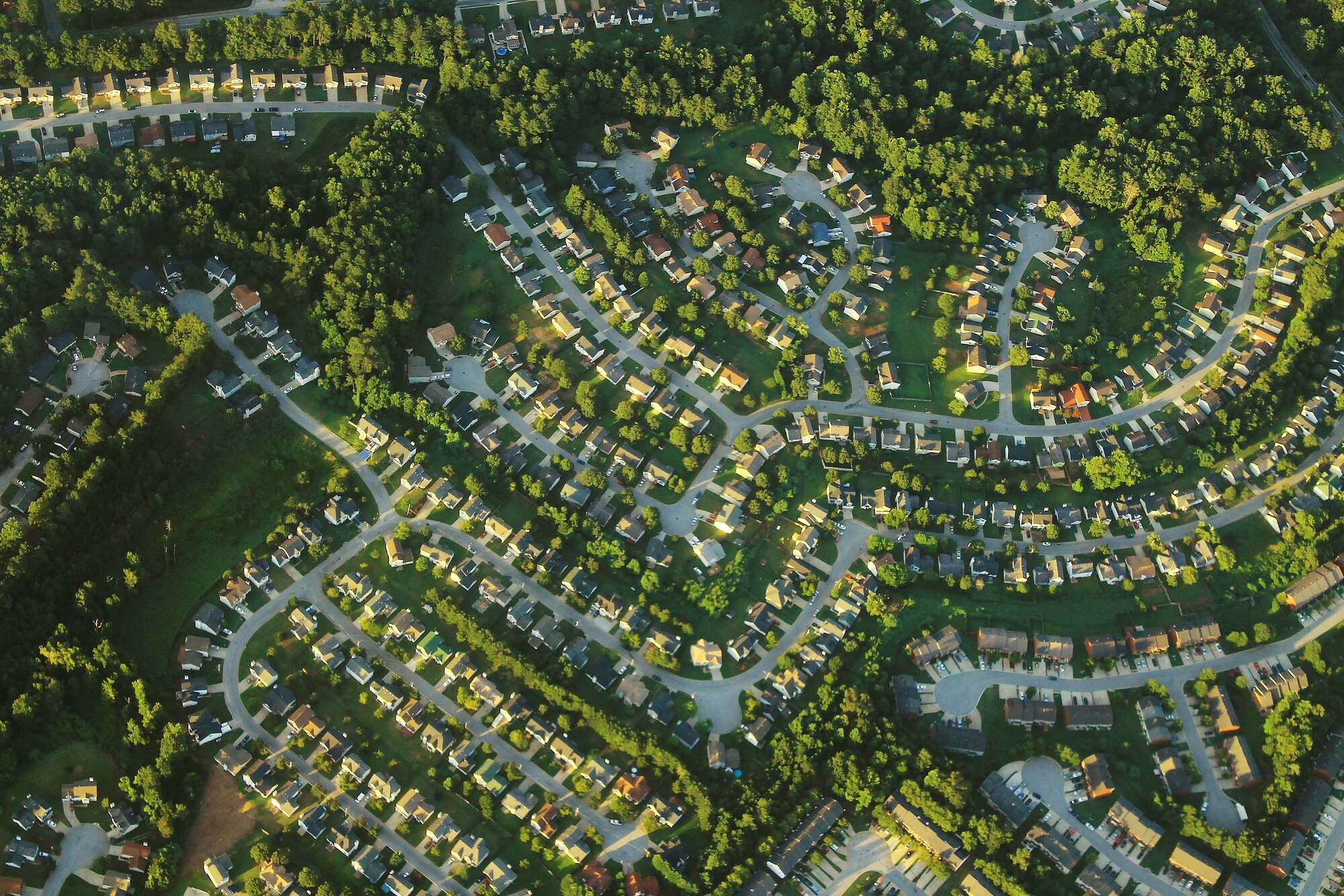
Residential neighborhood near Atlanta, Georgia, U.S.A.. Green lawns can be observed in front of every home. Photo by Formulanone (Wikimedia Commons, Creative Commons, Attribution-Share Alike 2.0 Generic license. Photo resized.)
Recreation
Lawns used for recreational activities can surround a single-family home, or can be found in private and public places, like in parks, around schools, and in front of office buildings. For children and pets, lawns are safe areas to play and run around. More formal lawn games have been created specifically for social gatherings and have been played for hundreds of years. Common lawn games include corn hole, croquet, horseshoes, and kamjam.
Lawns can be places of gathering for large groups of people, whether family, friends, people from work, or even strangers. Often, groups will use lawns for social functions, picnics, grilling, and relaxing. Large grass lawns can easily to accommodate many people for organized events, like concerts. Some outdoor sports, such as baseball, golf, soccer, field hockey, and lacrosse, are played on lawns.

A young girl and boy chasing each other in the grass. Photo by Mikhail Nilov (Pexels, use follows Pexels license. Photo resized.)

A dog playing with a tennis ball in the grass. Photo by Viktoria Borodinova (Wikimedia Commons, Creative Commons Attribution-Share Alike 4.0 International license, photo resized.)
Damage prevention
Lawns have practical purposes in helping prevent damage to buildings, particularly homes. For example, lawns can help prevent damage to homes caused by falling trees; by clearing a plot of land around a house, there is less of a threat of trees or branches falling on the house during a storm. In fire-prone areas, lawns can slow down the spread of a wildfire because there is less dense greenery to provide fuel for fires. Trees and other dense vegetation near a four-season home may be undesirable because they can promote the retention of moisture, which can lead to moisture damage. Root systems from large plants can also uplift sidewalks uplift sidewalks, home foundations, or underground utilities (like sewer pipes or septic systems) if the roots expand under the home or into utility lines.
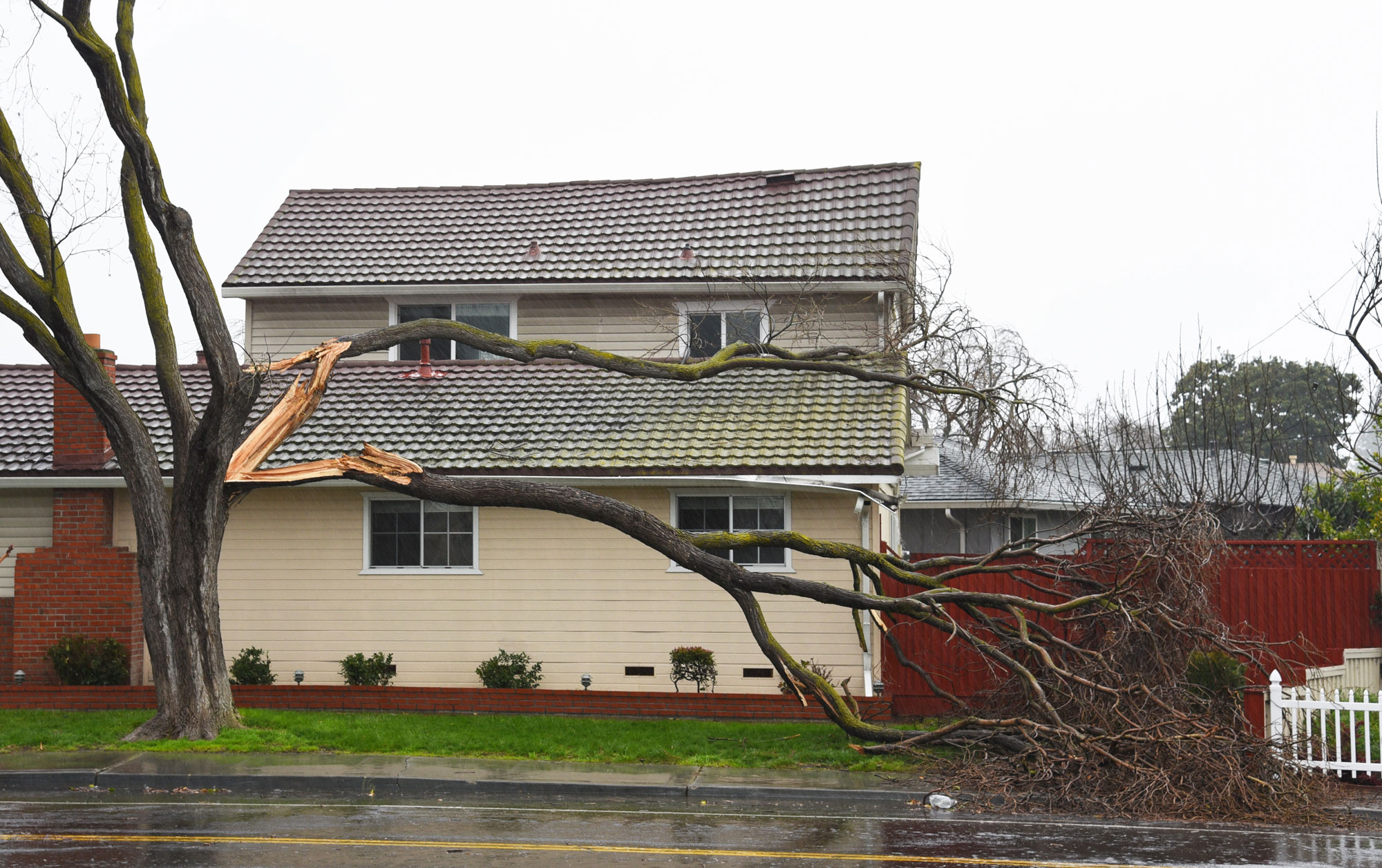
Although lawns may help protect houses from damage due to falling trees or tree limbs, the protective function depends on the height of the tree and distance from the house. Santa Clara, California. Photo by Ian Abbott (flickr, Creative Commons Attribution-NonCommercial-ShareAlike 2.0 Generic license, photo resized.)
Deterring pests
In some regions, lawns can serve to protect buildings from being invaded by pests like mice, rats, and chipmunks. Lawns can also protect pets and people from encountering ticks. Ticks are a type of parasite that have mouthparts that dig into the skin, which they use to feed on the blood of mammals, birds, and other animals. While feeding, they are known to inject toxins that can cause allergic reactions and spread diseases. In the U.S., lyme disease, a disease caused by the bacterium Borrelia burgdorferi, is one of the most common tick-borne diseases. Other tick-borne diseases found in the U.S. include Rocky Mountain spotted fever, anaplasmosis, and babesiosis.
Cutting lawn grass greatly decreases the chances of encountering ticks because they are often found in long, tall grass and brush. For this reason, the CDC recommends lawn mowing and other landscaping measures to keep ticks out of yards where people and pets are active.

A tick on a plant. Photo by Thomas Bresson (Wikimedia Commons, Creative Commons Attribution 2.0 Generic license, photo resized.)
Drawbacks of manicured lawns
While manicured lawns can be beautiful and provide many benefits, they also have distinct drawbacks. Some of these are listed below.
Impacts on biodiversity
Lawns are often made up of a uniform, dense carpet made up of a single grass species (or, perhaps, several species), and they lack the diversity of native ecosystems. Native plants provide nectar and pollen to bees, butterflies, and other insects. Lawns replace these food sources, which can cause a decrease in pollinator populations. Pollinating insects are essential for the reproduction of many flowering plants, including many types of crop plants. Lawns also impact wildlife habitat because they provide little shelter and food, nor areas for nesting. Creating a balance between native habitats and manicured lawns is essential to protect native wildlife and pollinators.
Lawn grasses often are not native to the local ecosystem in which they are cultivated. In some cases, non-native grasses can become invasive and outcompete native vegetation, decreasing overall plant diversity. Some of the lawn grass species listed above are considered invasive in some U.S. states.
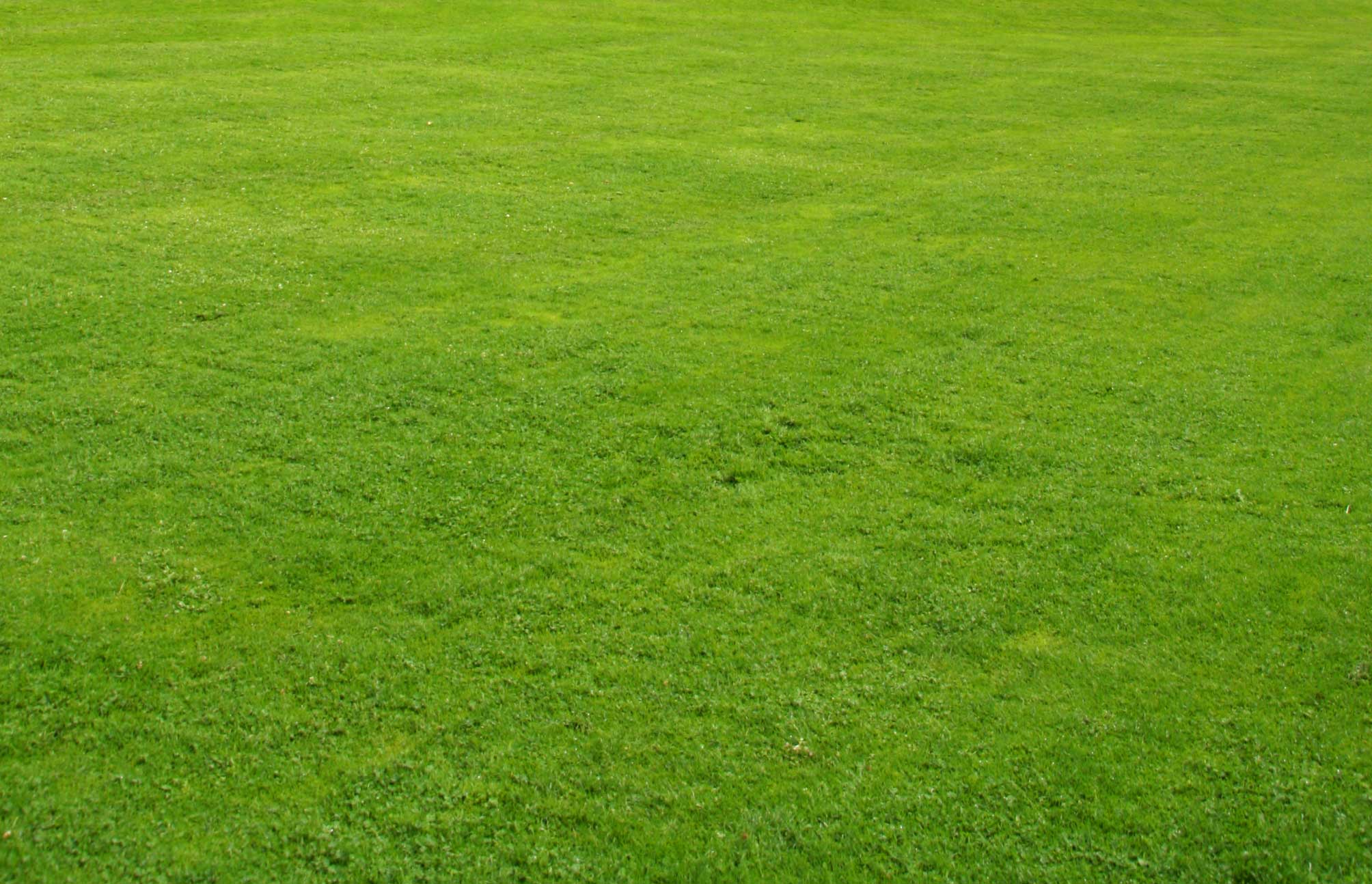
A green mowed lawn. Photo by Marek Slusarczyk (Wikimedia Commons, Creative Commons Attribution 3.0 Unported license).
Air pollution
Gas-powered equipment used for lawn maintenance such as lawn mowers, leaf blowers, chainsaws, and trimmers burn fossil fuels and emit carbon monoxide, nitrogen oxides, volatile organic compounds, and other particulate matter. Lawn fertilizers that are applied excessively or improperly can release nitrogen and become airborne drifting into non-target areas. In the United States, gas-powered equipment contributes to 17% of all volatile organic compound (VOC) emissions and 29% of all carbon monoxide (CO) emissions.
Burning fossil fuels is gas-powered lawn maintenance equipment also adds greenhouse gases (such as carbon dioxide, CO2) to the atmosphere, contributing to climate change. The U.S. Environmental Protection Agency (EPA) estimates that gasoline-powered machines for lawn care—including leaf blowers, mowers, and trimmers (weed wackers)—burn more than 800 million gallons of gasoline per year. The EPA estimates that off-road, gasoline-powered equipment emits 242 million tons of pollutants annually, almost as much as cars and homes.
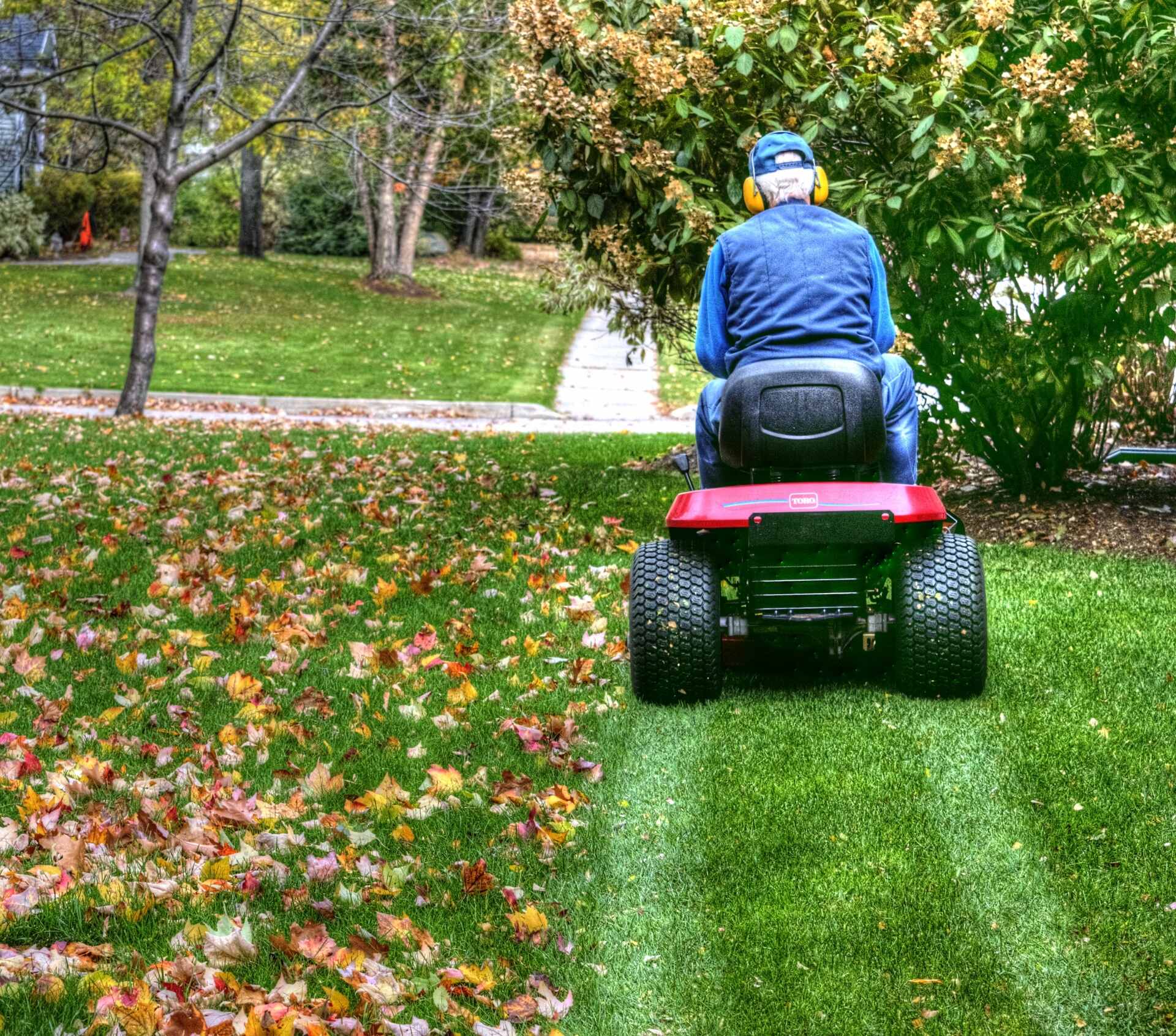
Man riding a gas-powered lawn-mower to cut the lawn and the fall foliage. Photo by Linnaea Mallette (CC0 Public Domain).
Noise pollution
The engines from lawn mowers and other gas powered tools, especially older models, generate loud noises. In residential areas and other areas where lawns are maintained, the sounds of lawn mowers disturb the tranquility of residents and wildlife.
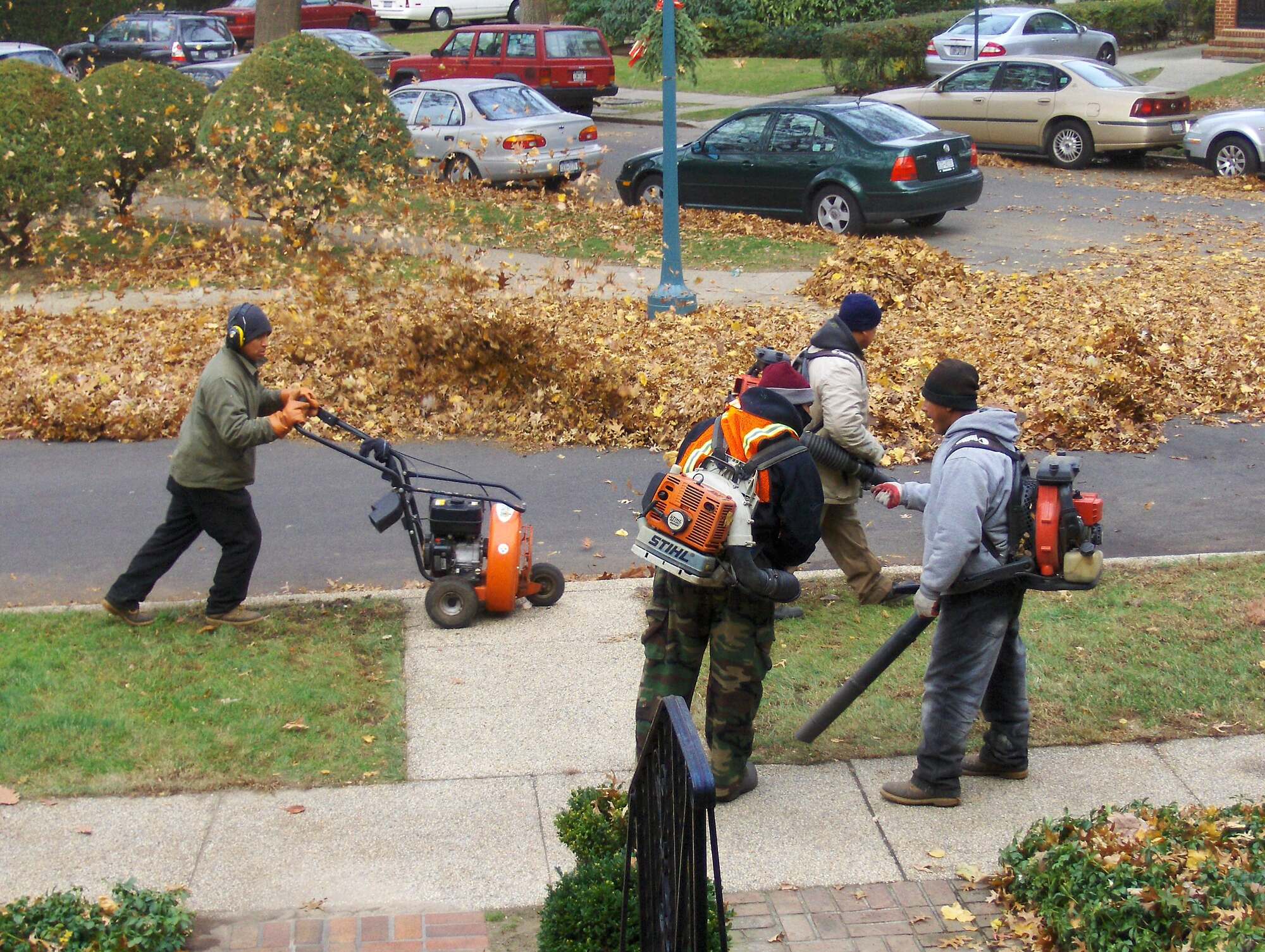
Four men using leaf blowers to blow the fall foliage off of lawns. These gas-powered machines create lots of noise. Photo by Peter Dutton (Wikimedia Commons, Creative Commons Attribution 2.0 Generic license, photo resized.)
Water depletion
Lawns require a significant amount of water to stay green, especially when the grass is non-native and are not adapted to the local climate. In some regions, especially hot, dry areas with little access to clean water, watering lawns to keep them green can deplete water supplies, a problem that can become especially acute during droughts.

A housing development in Los Angeles, California, 2012. Note the houses surrounded by green lawns in contrast with the yellow and brown vegetation in undeveloped areas of this dry landscape. Photo by Carol M. Highsmith (GPA Photo Archive on flickr, Creative Commons Attribution-NonCommercial 2.0 Generic license, image resized).
Water pollution
Lawns can also contribute to the formation of harmful algal blooms (HABs) that can harm pets, wild animals, and even humans. HABs occur when excessive amounts of nitrogen and phosphorus from fertilizers—such as those used on agricultural fields and to maintain lawns—wash into lakes, oceans, or other bodies of water. Combined with warm water temperatures, these nutrients promote the growth of algae. As the population of algae increases, the water may appear green, red, brown, or turquoise. Some algae that cause HABs release harmful toxins, and any algal bloom can deplete the oxygen in the water, which can suffocate fish and other aquatic life.

A harmful algae bloom in front of residential areas, Lake Erie, New York. Photo by NOAA Great Lakes Environmental Research Laboratory. Wikimedia Commons. CC BY 2.0 license
Lawn alternatives
Different options are available to replace traditional grass lawns. These options can save time, money, effort, and, in some circumstances, they can be better for the environment. Low maintenance alternatives to lawns include using moss, ground covers, or eco-lawn mixtures. These options can be paired with personalized, fun, and creative backyard designs to create welcoming spaces that still appear manicured.
Some possibilities for decorating the exterior that are aesthetically pleasing include planting wildflower gardens or different ornamental grasses and using decorative stone and other elements. Flowers or ornamental grasses add life and color, and greenery can promote relaxation and a connection with nature.
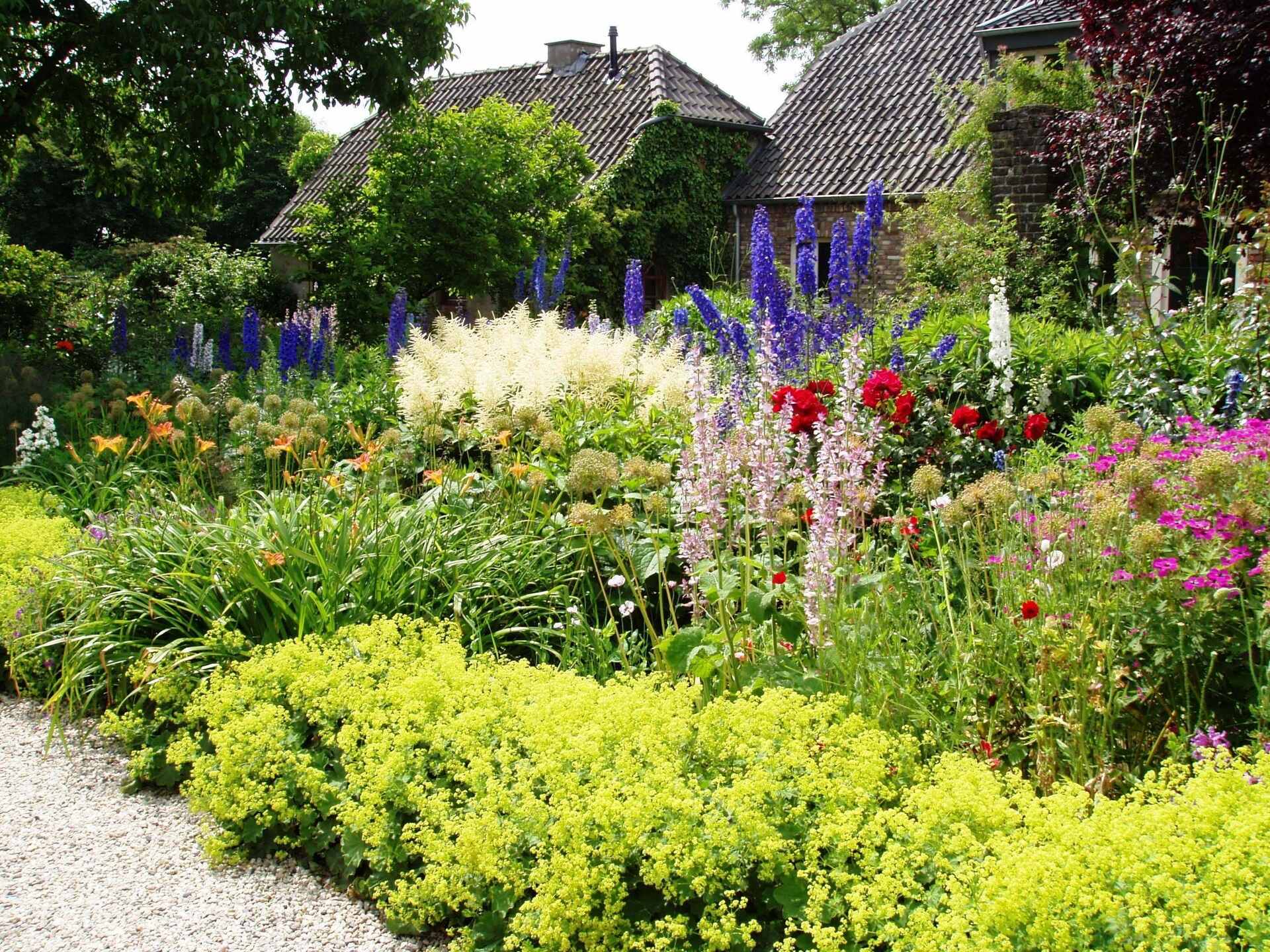
An example of incorporating a mix of cultivated flowers into an aesthetically pleasing backyard. The flowers and grasses attract pollinators. Photo by PxHere (CC0 Public Domain)
Moss
A moss carpet is a lawn alternative that originated in Japan and can be found in Japanese-inspired gardens around the world. Moss is known for its soft, lush texture. It requires a lot of moisture, so it is not suitable for all environments. When grown in a suitable environment, moss lawns require no mowing and less watering than traditional lawns, and the use of herbicides or manual weed removal is not necessary, because the dense moss mat suppresses weed growth. Moss lawns cannot withstand hot, dry climates nor high levels of foot traffic. Stone pathways are often built through moss lawns to prevent damage.

Most commonly, moss lawns are used around stone paths and are often built along a body of water, providing the necessary moisture. The photo above is a garden that honors a prominent Japanese scholar and diplomat, Dr. Inazō Nitobe. Vancouver, British Columbia, Canada. Photo by Jennifer C. (Wikimedia Commons, Creative Commons Attribution - Share Alike 2.0 Generic license. Photo resized.)
Wildflower gardens
Native flowering plants are an aesthetically pleasing option to replace traditional lawns. Not only do they save time, money, and effort, but they also have environmental benefits. Native plants are well adapted to the local climate and, thus, they require less water. They coexist well with local wild plants and grasses and provide food and habitat for the local wildlife. Thus, they can aid in water conservation and enhancement of local biodiversity. Flowering plants attract butterflies and other pollinators with their diverse range of vibrant colors. Native plants also require less fertilizer, less pesticide application, and less mowing than a grass lawn.
Some wildflower gardens combine native and non-native species. Non-native species may provide bold colors and can also be low maintenance and relatively environmentally friendly if well chosen.
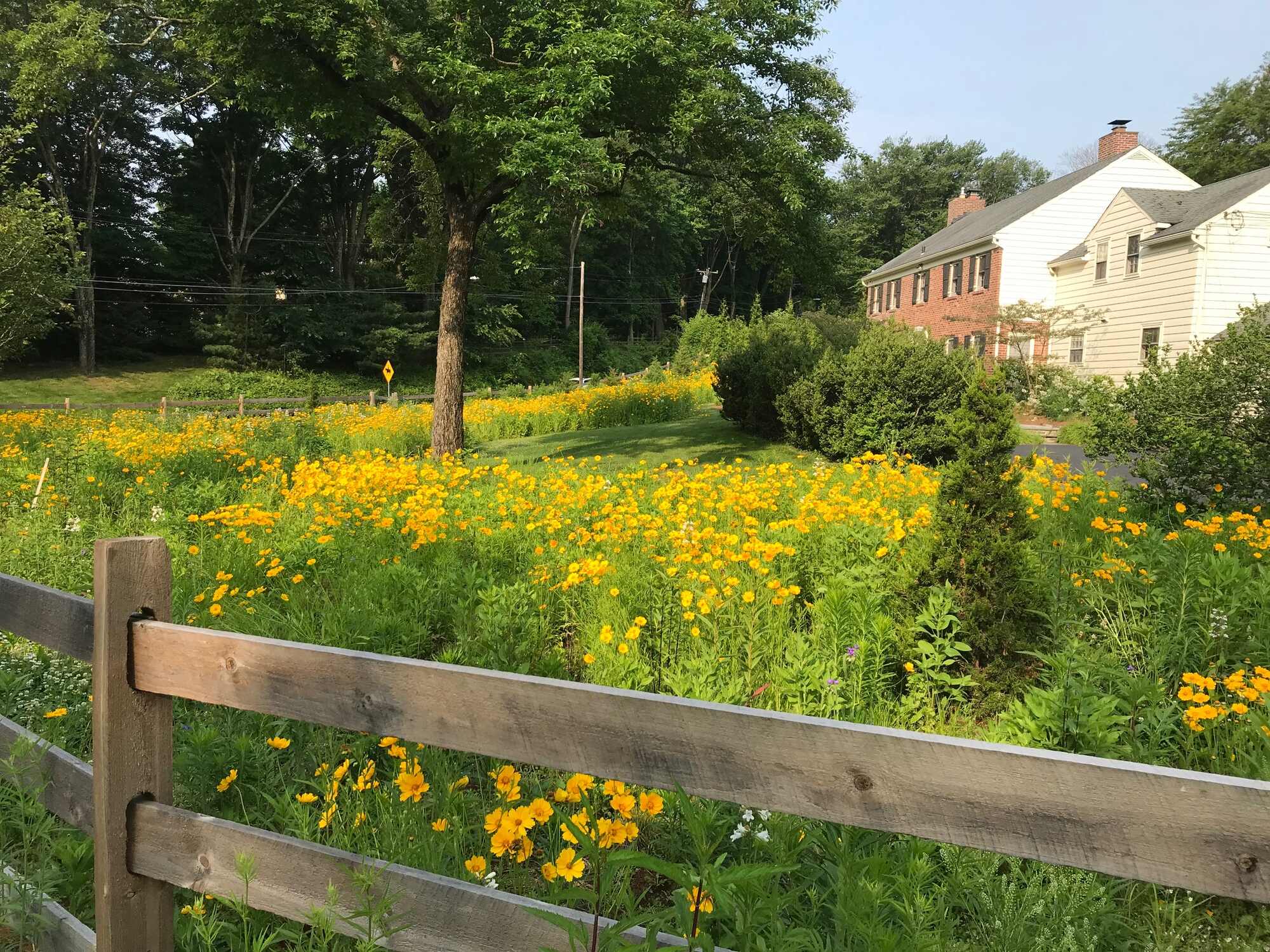
A yard of yellow flowers with a mix of native grasses and other plants. A great example of a naturalized front lawn. Photo by Montgomery Township Planning Commission (Wikimedia Commons, Creative Commons Attribution-Share Alike 2.0 Generic license, photo resized.)
Ground covers
Ground covers are typically creeping flowering plants that require less maintenance than regular lawns, aid in weed suppression, and are used to fill specific areas of landscape. Ground covers can be a visually appealing, low-maintenance alternative to grass. Unfortunately, probably due to their tendency to spread over the ground and require little care, some ground covers have become invasive weeds in natural habitats. These plants should avoided in regions where they have become weedy, if not altogether.
Examples of ground covers include:
- Common periwinkle (Vinca minor): Favored for its periwinkle purple flowers, this plant has a tendency to spread into forests and displace native plants. Common periwinkle is listed as an invasive weed in parts of the U.S.
- Corsican mint (Mentha requienii): A creeping plant known for its pleasant aroma.
- Creeping Jenny or moneywort (Lysimachia nummularia): Known for its yellow flowers, creeping Jenny has a tendency to spread into many natural habitats where water is abundant. Listed as an invasive weed in parts of the U.S.
- Hens and chicks (Sempervivum), house leek (Sempervivum tectorum): Popular succulents known for needing little water.
- Lilyturf or mondo (Ophiopogon japonicus): A plant with grass-like leaves that is often used as a ground cover because it is dense, dark green, and drought tolerant. Lilyturf is included on at least one invasive species list in the U.S.
- Sedum (Sedum spp.): A plant with colorful foliage that can grow in dry, rocky areas. At least one species, stringy stonecrop (Sedum sarmentosum), is considered invasive in West Virginia.
- White clover (Trifolium repens): Clover is a type of legume that has roots that harbor nitrogen-fixating bacteria that enrich the soil; it is also more drought-tolerant than traditional lawn grass, and its flowers provide nectar for bees. Nevertheless, white clover is considered invasive in some U.S. states, and the Missouri Botanical Garden recommends against planting it in the Midwestern U.S.
- Wild thyme or mother of thyme (Thymus praecox and Thymus serpyllum): Trendy for its colorful flowers; Thymus praecox is listed as invasive in at least one U.S. county.
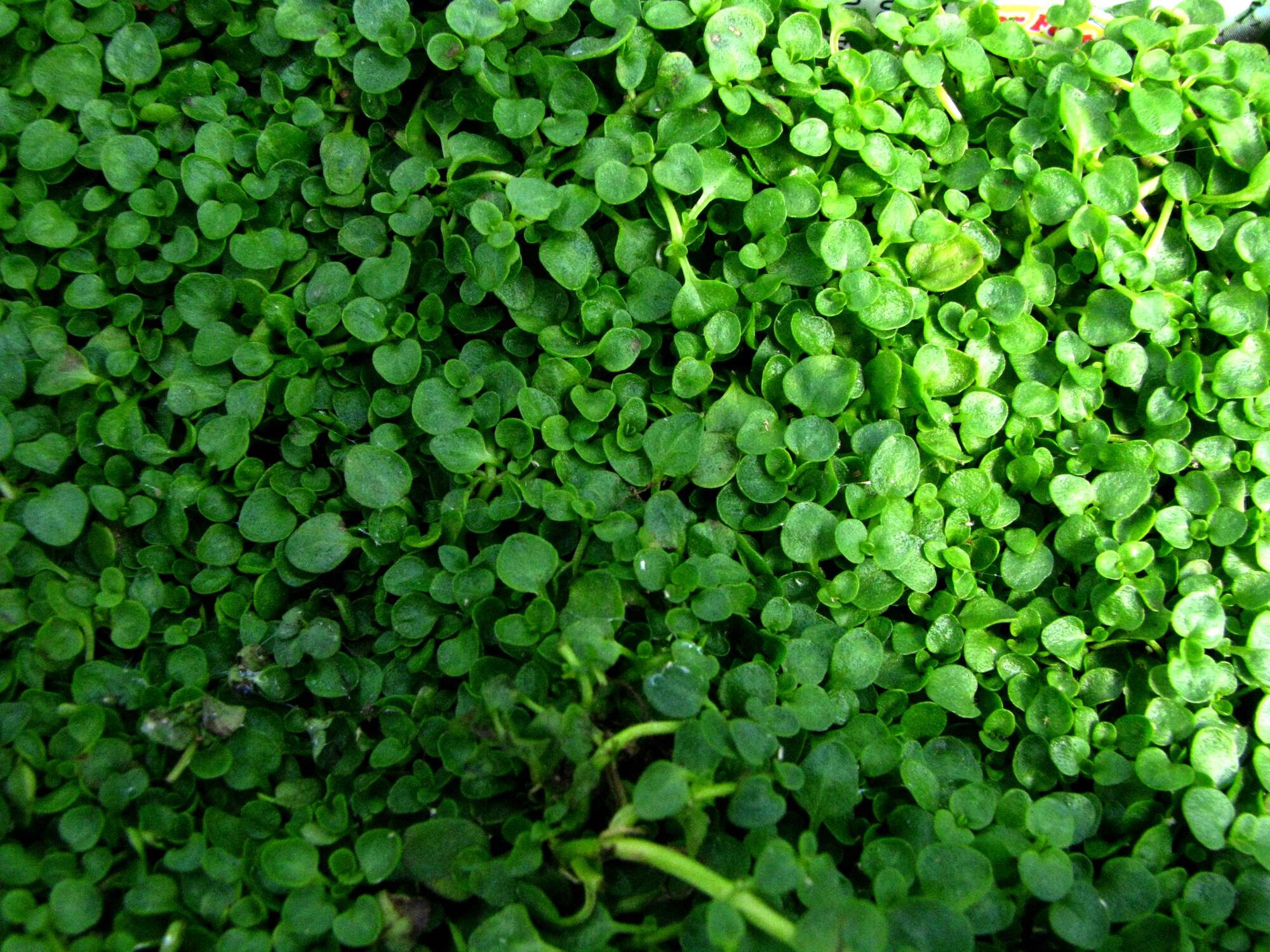
Corsican mint, sometimes used as a ground cover because of its aroma. Pearl City, Hawaii. Photo by David Eickhoff (Wikimedia Commons, Creative Commons, Attribution 2.0 Generic license, photo resized.)

A large patch of clover in a lawn in Virginia, U.S.A. The white flowers attract pollinators, especially bees. However, white clover is considered invasive in some regions. Photo by Famartin (Wikimedia Commons, Creative Commons Attribution-Share Alike 4.0 International license, photo resized).
Sustainable practices for maintaining a lawn
Many people live in a residential development where they are not given a choice of whether to maintain a lawn, or where they prefer a lawn for various reasons. In such cases, the negative environmental impacts of lawns can be reduced. Below are some sustainable practices for maintaining a lawn in a more environmentally friendly manner:
- Choose lawn grass wisely: By choosing a native grass species for the lawn, less water, fertilizer, and maintenance will be needed to keep it healthy. If living in a hot area, choose a grass that is drought tolerant to prevent excess watering.
- Consult with local experts: Before growing a non-native plant or grass, investigate whether it is considered invasive. Research online or reach out to native plant organizations, landscaping professionals, local conservation agencies, or the local agricultural extension office.
- Avoid overwatering: Watering too frequently leads to wasted water and shallow roots. If living in an area that receives sufficient precipitation, consider not watering.
- Use organic fertilizers: Composting is a great alternative fertilizer because it releases its nutrients slowly and is less likely to run off into local water bodies. Leave grass clippings on the lawn as mulch so that the clippings will decompose and return nutrients to the soil.
- Avoid herbicides and pesticides: Carefully consider whether herbicides and pesticides are necessary to maintain your lawn.
- Choose lawn maintenance equipment carefully: Consider purchasing a mower with minimal decibels to reduce noise pollution. When practical, consider electric rather than a gas-powered lawn maintenance equipment.
- Promote biodiversity: Designate an area of the yard for wildflowers and native plants in order to promote habitat and food for local wildlife.
- Be aware of runoff: If you have a waterfront property, allow native plants to grow near the water's edge to create a barrier from runoff.
- Raise awareness: Bring up the impact of lawns on ecosystems to your neighbors or in residential association meetings. If you live on or near a waterfront, be sure to discuss the impacts of fertilizers and potential consequences of HABs to your neighbors.
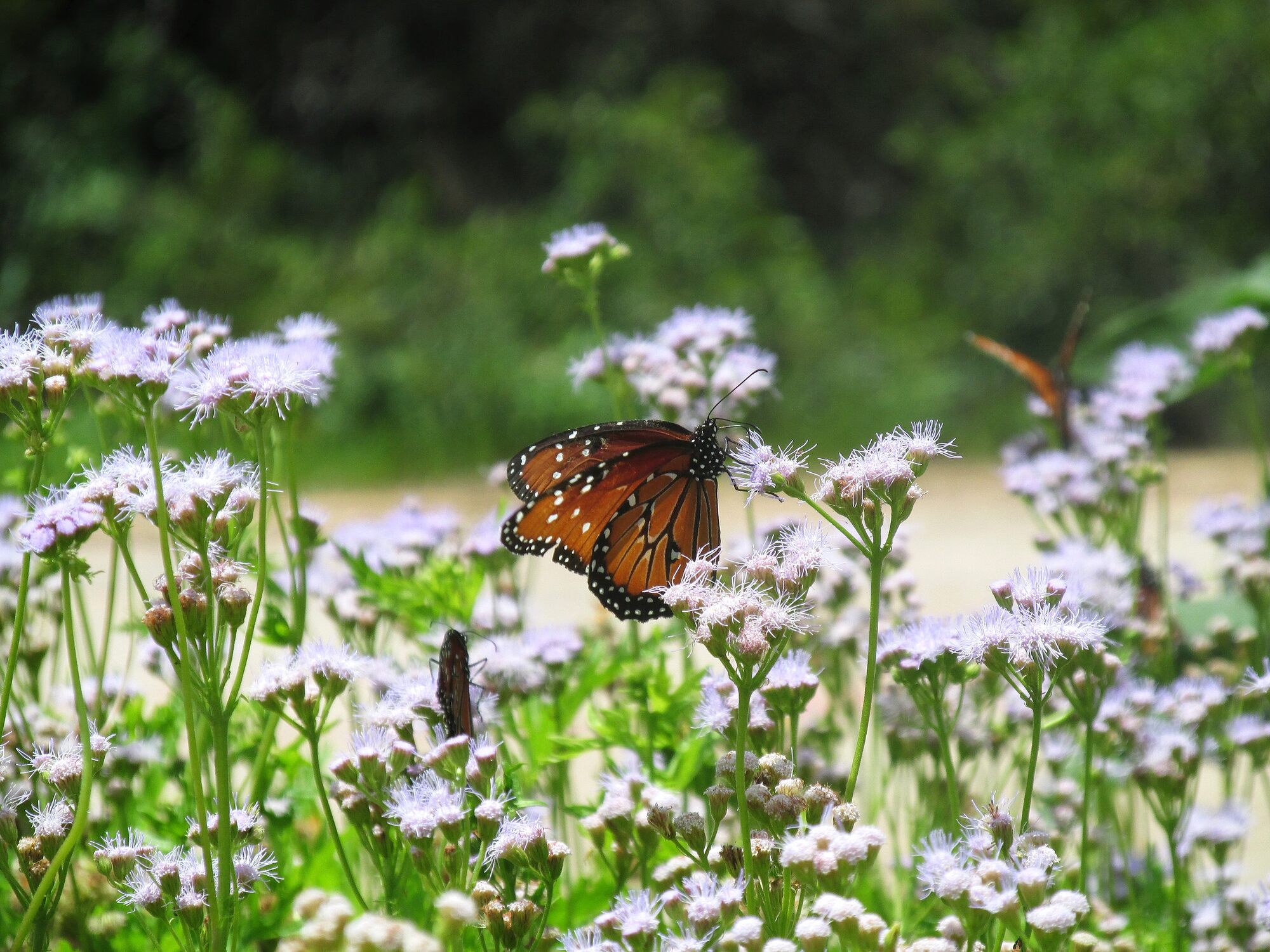
Monarch butterflies and a grasshopper enjoying the flowers. Growing wildflowers, attracts pollinators such as beautiful butterflies and other wildlife. Photo by Chad Sparkes (flickr, Creative Commons Attribution 2.0 Generic license, photo cropped and resized.)
Resources
Websites
Missouri Botanical Garden Plant Finder (searchable database of garden and landscape plants): http://www.missouribotanicalgarden.org/plantfinder/plantfindersearch.aspx
Preventing ticks in the yard (US Centers for Disease Control and Prevention): https://www.cdc.gov/lyme/prev/in_the_yard.html
Sustainable Landscaping (New York State Department of Environmental Conservation): https://www.dec.ny.gov/public/44290.html
Articles & reports
Banks, J. L., and R. McConnell. National emissions from lawn and garden equipment. U.S. Environmental Protection Agency. https://www.epa.gov/sites/default/files/2015-09/documents/banks.pdf
Hassani, N. 2023. How to grow a moss lawn: Benefits, disadvantages & tips. The Sustainable Lush Green Alternative to Turfgrass. The Spruce, March 7. 2023. https://www.thespruce.com/create-low-maintenance-moss-lawn-2152704
Sansone, A. E., and A. Gautieri. 2023. 28 best ground cover plants that require little maintenance. Good Housekeeping, March 23, 2023. https://www.goodhousekeeping.com/home/gardening/g32440508/best-ground-cover-plants/
Scientific articles
Birk, S., J. D. Miller, A. MacMillan, R. T. Patterson, and P. J. Villeneuve. 2023. Perceptions of freshwater algal blooms, causes and health among New Brunswick lakefront property owners. Environmental Management 71: 249-259. https://doi.org/10.1007%2Fs00267-022-01736-2



